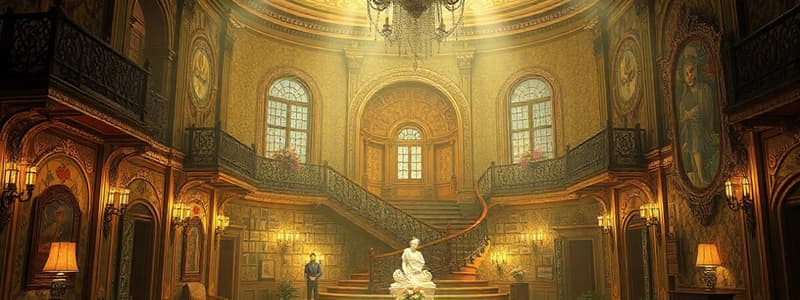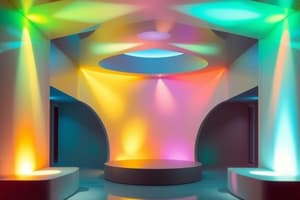Podcast
Questions and Answers
What is the primary purpose of maintaining a written record of lighting cues?
What is the primary purpose of maintaining a written record of lighting cues?
- To provide a visual guide during performances
- To back up the lighting design and ensure safety (correct)
- To ensure the lighting operator can create new cues
- To replace the lighting control board memory
What type of rehearsal primarily allows lighting and audio technicians to address technical aspects without the full performance?
What type of rehearsal primarily allows lighting and audio technicians to address technical aspects without the full performance?
- Dress rehearsal
- Cue sheet testing
- Q-2-Q rehearsal (correct)
- Dry tech rehearsal
What factors can obstruct the lighting operator's line of sight during a performance?
What factors can obstruct the lighting operator's line of sight during a performance?
- Microphone placements and actor positions
- Stage elements, structural elements, and glare (correct)
- Sound cues and backstage movements
- Dimming settings and color gels
What is a key step involved after entering cues into a lighting control console?
What is a key step involved after entering cues into a lighting control console?
Who typically participates in testing sessions after cues have been entered into the lighting control console?
Who typically participates in testing sessions after cues have been entered into the lighting control console?
What is the primary responsibility of the lighting designer during the level session?
What is the primary responsibility of the lighting designer during the level session?
What role does the 'walker' serve during the lighting cue setting session?
What role does the 'walker' serve during the lighting cue setting session?
Why is it essential to properly document the lighting cues on a cue sheet?
Why is it essential to properly document the lighting cues on a cue sheet?
During which phase of lighting design is the level or cue setting session conducted?
During which phase of lighting design is the level or cue setting session conducted?
Which of the following is NOT typically present during the level session?
Which of the following is NOT typically present during the level session?
What is the main purpose of assigning cue numbers during the level session?
What is the main purpose of assigning cue numbers during the level session?
Which factor can affect the time taken to fully balance each cue during the level setting session?
Which factor can affect the time taken to fully balance each cue during the level setting session?
During the level session, what does the term 'walker' refer to?
During the level session, what does the term 'walker' refer to?
What aspect of the cue sheet makes it essential for lighting designers, particularly when using manual systems?
What aspect of the cue sheet makes it essential for lighting designers, particularly when using manual systems?
What role does the lighting designer play during the lighting pictures session?
What role does the lighting designer play during the lighting pictures session?
What is a critical consideration for lighting operators when entering cues into the control console?
What is a critical consideration for lighting operators when entering cues into the control console?
During the dry tech rehearsal, what is primarily checked and fixed?
During the dry tech rehearsal, what is primarily checked and fixed?
In a Q-2-Q rehearsal, what is the main focus for the technical team?
In a Q-2-Q rehearsal, what is the main focus for the technical team?
What is the purpose of maintaining an unobstructed line of sight for a lighting operator?
What is the purpose of maintaining an unobstructed line of sight for a lighting operator?
What happens during the dress rehearsal in theatrical productions?
What happens during the dress rehearsal in theatrical productions?
What is the primary reason for maintaining a 'cue sheet' during a lighting session?
What is the primary reason for maintaining a 'cue sheet' during a lighting session?
How does an electronic memory in a lighting control board benefit the lighting operator?
How does an electronic memory in a lighting control board benefit the lighting operator?
What is a potential drawback of relying solely on electronic memory for lighting cues?
What is a potential drawback of relying solely on electronic memory for lighting cues?
Which of the following accurately reflects the role of an experienced operator when training someone on a lighting control desk?
Which of the following accurately reflects the role of an experienced operator when training someone on a lighting control desk?
What aspect of the lighting design process does the cue entering stage require careful consideration?
What aspect of the lighting design process does the cue entering stage require careful consideration?
Flashcards are hidden until you start studying
Study Notes
Lighting Design Process
- Lighting instruments are assigned to dimmers and focused during a focus session.
- A cue setting session follows where the lighting designer creates 'lighting pictures'.
- Key personnel involved: lighting designer, director, stage manager, and lighting operator.
- The team works around the lighting control desk in a dark auditorium, progressing through the show sequentially.
- Each lighting change is assigned a cue number and time for the stage manager to document in the script.
Role of the Stage Walker
- The 'stage walker' dresses in typical costume tones to help check lighting levels on stage.
- The walker moves according to the actors' blocking, which helps the designer assess lighting effectiveness.
- Approval of each lighting 'look' results in it being recorded on a cue sheet by the lighting designer or head electrician.
Cue Sheet Documentation
- Cue sheets document each lighting cue, consisting of channel numbers and levels.
- Essential for both manual systems without electronic memory and as a backup for electronic systems.
- Proper documentation ensures the lighting designer's setup is easily retrievable, preventing issues from lost memory.
Lighting Control Desk Operations
- Computer-assisted lighting control systems are now standard, allowing information from cue sheets to be entered into memory.
- Operators often need training and assistance from experienced users to learn the entry process.
- Timelines for cue entry should consider the time required for new operators to train effectively.
Importance of Line of Sight
- Effective lighting operation relies on clear visibility of stage cues for transitions.
- Obstructions that may impede sight include stage elements, structural parts, and glare from lights.
- Testing cues with visual triggers is vital for ensuring an unobstructed line of sight.
Testing Lighting Cues
- Testing occurs after entering cues into the control console, ensuring proper sequencing and channel patching.
- Involves stage walkers, lighting designers, stage managers, and directors to check focus and fix errors.
- 'Dry tech' rehearsals allow technical teams to practice their cues and address any issues.
- 'Q-2-Q' (cue to cue) rehearsals focus on technical aspects without fully rehearsing all scenes, often including actors.
- Dress rehearsals involve full performance details with costumes and props, ensuring all aspects are prepared for the live show.
Lighting Design Process
- Lighting instruments are assigned to dimmers and focused during a focus session.
- A cue setting session follows where the lighting designer creates 'lighting pictures'.
- Key personnel involved: lighting designer, director, stage manager, and lighting operator.
- The team works around the lighting control desk in a dark auditorium, progressing through the show sequentially.
- Each lighting change is assigned a cue number and time for the stage manager to document in the script.
Role of the Stage Walker
- The 'stage walker' dresses in typical costume tones to help check lighting levels on stage.
- The walker moves according to the actors' blocking, which helps the designer assess lighting effectiveness.
- Approval of each lighting 'look' results in it being recorded on a cue sheet by the lighting designer or head electrician.
Cue Sheet Documentation
- Cue sheets document each lighting cue, consisting of channel numbers and levels.
- Essential for both manual systems without electronic memory and as a backup for electronic systems.
- Proper documentation ensures the lighting designer's setup is easily retrievable, preventing issues from lost memory.
Lighting Control Desk Operations
- Computer-assisted lighting control systems are now standard, allowing information from cue sheets to be entered into memory.
- Operators often need training and assistance from experienced users to learn the entry process.
- Timelines for cue entry should consider the time required for new operators to train effectively.
Importance of Line of Sight
- Effective lighting operation relies on clear visibility of stage cues for transitions.
- Obstructions that may impede sight include stage elements, structural parts, and glare from lights.
- Testing cues with visual triggers is vital for ensuring an unobstructed line of sight.
Testing Lighting Cues
- Testing occurs after entering cues into the control console, ensuring proper sequencing and channel patching.
- Involves stage walkers, lighting designers, stage managers, and directors to check focus and fix errors.
- 'Dry tech' rehearsals allow technical teams to practice their cues and address any issues.
- 'Q-2-Q' (cue to cue) rehearsals focus on technical aspects without fully rehearsing all scenes, often including actors.
- Dress rehearsals involve full performance details with costumes and props, ensuring all aspects are prepared for the live show.
Lighting Cue Documentation
- During a 'level session', lighting looks are built one dimmer at a time, requiring precision.
- Balancing each light cue can take from one minute to over an hour.
- ‘Cue sheet’ serves as essential written documentation for each lighting cue.
- A cue sheet typically includes columns for dimmer (or channel) numbers and records levels for each cue along with its number and time.
Importance of Cue Sheets
- In manual lighting control systems without electronic memory, cue sheets are the only record of lighting configurations.
- Written cue sheets are also important for backup even in systems with electronic memory.
- Maintaining a documented record is crucial due to potential loss of memory in lighting control systems.
Role of Lighting Designers
- Lighting designers invest significant time and effort in achieving balance and obtaining approval from directors.
- Lack of a written record for the lighting session can lead to operational risks.
Modern Lighting Control
- Computer-assisted lighting control desks have become standard in contemporary setups.
- Operators use cue sheets to input data into the lighting control console memory.
- Familiarity with the specific lighting desk model requires training and practice for effective operation.
Learning Considerations
- New operators typically receive guidance from experienced personnel during the learning process.
- Adequate time for mastering cue entry and understanding lighting control systems is necessary, especially under tight timelines for performances or events.
Studying That Suits You
Use AI to generate personalized quizzes and flashcards to suit your learning preferences.




